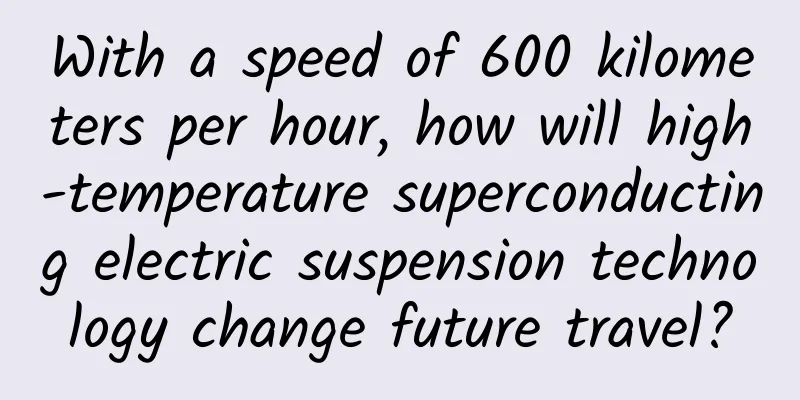With a speed of 600 kilometers per hour, how will high-temperature superconducting electric suspension technology change future travel?

|
If you go from Beijing to Shanghai 1200 kilometers can be reached in two hours by train Does it sound like a joke? The 600 km/h train has not yet been put into practical use. But it may become a reality in the near future. Recently, the first domestic high-temperature superconducting electric suspension full-element test system independently developed by CRRC Changchun Railway Vehicles Co., Ltd. completed its first suspension operation, which marks an important technological breakthrough in my country's field of high-temperature superconducting electric suspension. During the test, the test vehicle entered the suspension area after traveling 68 meters, at which time it was accelerated to 50 kilometers per hour. After entering the suspension area, the vehicle's support wheels detached from the running surface and successfully entered the electric suspension stage, which lasted for 4 seconds. The test was a complete success. Although it was only 4 seconds, it brought the high-temperature superconducting electric levitation train one step closer to us, and the running speed of this type of train can easily reach over 600 kilometers per hour. What is high-temperature superconducting electric levitation? What changes will it bring to our future travel? Is it safe to ride a high-temperature superconducting electric levitation train? When will we be able to experience its flying speed? Let’s find the answer together↓↓↓ Why is close to -200℃ considered “high temperature”? What is high-temperature superconductivity? How high a temperature does the “high temperature” here refer to? Superconductivity refers to the phenomenon that the resistance of certain materials disappears at extremely low temperatures, that is, zero resistance. Many materials can only achieve superconductivity at temperatures below -250°C. High-temperature superconductivity is achieved at liquid nitrogen temperatures, that is, above -196°C. Therefore, the high temperature in the high-temperature superconducting electric magnetic levitation system is not a few hundred or thousands of degrees, but close to -200°C. What is a high-temperature superconducting electric levitation transportation system? Now that we know the two characteristics of high temperature and superconductivity, how are they applied to the design of rail transit? Compared with ordinary trains, what are the characteristics of high temperature superconducting electric suspension trains? High-temperature superconducting electric levitation is a new type of transportation that combines high-temperature superconducting technology with magnetic levitation technology. This technology uses the zero-resistance characteristics of high-temperature superconducting materials to pass large currents and generate strong magnetic fields. Through the interaction between the on-board superconducting magnet and the magnetic field of the ground coil, a contactless transportation method supported, guided and driven by magnetic force is achieved. Wu Wei, associate professor of electrical engineering at Shanghai Jiao Tong University: It will bring some additional benefits. One is that the high-temperature superconducting magnets on board can use low-cost cooling methods to maintain the advantages of zero-resistance transmission of large currents. In addition, although it is an electromagnet, once current is injected into it, it can work without any power supply. Experts conducted experiments by tying a metal wrench with a rope. When the wrench was 30 cm away from the superconducting electromagnet, it was firmly attracted. Wu Wei, Associate Professor of Electrical Engineering Department of Shanghai Jiao Tong University: In this way, we can give you an intuitive feeling of how strong its magnetic field is. From a quantitative point of view, the maximum magnetic field inside the magnet can reach 3 Tesla, which is a unit of magnetic induction intensity and is about 100,000 times that of the Earth's magnetic field. Strong magnetic force is a prerequisite for the maglev system to achieve a larger suspension and guidance gap, which means that vehicle safety control can be done more efficiently, and secondly, its track construction cost can be significantly reduced. How will high-temperature superconducting electric suspension technology change future travel? High-temperature superconducting electric suspension technology is considered one of the "highest points" of the world's current rail transportation technology. What kind of changes will this cutting-edge technology bring to future travel? High-temperature superconducting electric levitation is a new type of high-tech, large-scale transportation. It can drive the development of basic disciplines such as electricity, electromagnetism, and materials science, and can promote the development of upstream and downstream industrial chains such as power electronics, communications, and infrastructure. In addition, the speed of operation can reach more than 600 kilometers per hour, which will also optimize traffic operations. Shao Nan, deputy director of the System Technology Office of CRRC Changchun Maglev Research Institute: In the future, we hope that it can fill the speed gap between high-speed rail and airplanes, shorten people's travel time and improve travel efficiency. If high-speed maglev can be applied, the first scenario may be in economically developed and densely populated areas in our country, such as Beijing-Tianjin-Hebei, Yangtze River Delta, Pearl River Delta, Chengdu-Chongqing and other regions, where the integration of their transportation can be completed through high-speed maglev lines. Resources can be more reasonably allocated between these metropolitan areas, such as airport infrastructure resources, which is very conducive to regional economic development. Is it safe to ride a high-temperature superconducting electric levitation train? The speed can reach over 600 kilometers per hour, and it is suspended above the track, which is completely flying close to the ground. At such a high speed, is it safe to ride in a high-temperature superconducting electric suspension train? Experts said that compared with other transportation tracks, high-temperature superconducting levitation trains need to run in a U-shaped semi-enclosed track, so there is no derailment problem. In addition, the vehicle's levitation and guidance is achieved through the electromagnetic induction physical phenomenon between the on-board magnets and the ground coils. It is a passive self-stabilizing suspension that does not require active control, and has higher reliability in high-speed operation. Shao Nan, deputy director of the System Technology Office of CRRC Changchun Maglev Research Institute: Since we use high-temperature superconducting coils, through reasonable design, in the future use, even if the vehicle is powered off, the high-temperature superconducting coils can maintain the magnetic field without significant attenuation within 1 to 2 hours. In this way, the vehicle has enough time to travel to an area where rescue or evacuation is more convenient, and can brake reliably and stop smoothly. Not only that, experts say that the winding process of high-temperature superconducting coils also has its unique features. Shao Nan, deputy director of the System Technology Department of CRRC Changchun Maglev Research Institute: Our high-temperature superconducting coils have a very special winding process. Even if a part of the high-temperature superconducting coil fails or is damaged during use, the current inside will slowly decrease within a few hours. It will never suddenly lose current, which means that the driving state of our vehicle will not change suddenly, thus ensuring the safety of passengers. Which key "bottleneck" technologies have been broken through? High-temperature superconducting electric suspension is a high-tech product. It is a large system with a high degree of vehicle-track coupling, and involves many key technologies. According to the technical system, it can be divided into six categories: system integration, vehicles, track, traction power supply, operation control, and safety assurance. Many of these key technologies have been technically blocked by foreign countries. This time, my country's first high-temperature superconducting electric suspension full-element test system successfully completed its first suspension operation. What technical breakthroughs have been achieved in this process? According to experts, specialized technologies such as superconducting magnets, induction power supply, and line tracks have been subject to foreign technological blockades. However, after several years, domestic enterprises, universities, and research institutes have achieved certain interim results in the research of key technologies in various systems. Shao Nan, deputy director of the System Technology Office of CRRC Changchun Maglev Research Institute: The most difficult part for us is definitely the high-temperature superconducting magnet. There are no high-temperature superconducting magnets that can be mounted on vehicles in China. Some magnets that have been used before are large for ground applications, have high magnetic fields, and consume a lot of power, which are not suitable for vehicle applications. Therefore, for high-temperature superconducting magnets, such as the coils inside and the entire support structure, as well as the low-temperature constant temperature insulation structure outside, our joint R&D team has done a lot of hard work. The success of this suspension operation test has fully verified the key core technologies of superconducting electric suspension transportation systems, such as superconducting magnets, linear synchronous traction, induction power supply and cryogenic refrigeration, and laid a solid foundation for promoting the engineering application of superconducting electric maglev transportation systems. How far can we go with the "ground-close flight" at a speed of 600 kilometers per hour? When can we really experience this kind of "flying close to the ground" at a speed of 600 kilometers per hour? After my country's first high-temperature superconducting electric suspension full-element test system completed its first suspension operation recently, the person in charge of the project said that on this basis, my country actually has the ability to design engineering prototypes. The focus of the next step will be to carry out scheme design around the high-speed suspension engineering prototype, and it is expected that the manufacture of some components will be completed by the end of this year. I believe that in the near future, everyone will be able to ride on an electric suspension train. |
<<: Meritorious Person丨Sun Jiadong——the "Father of Satellites" who creates stars and fills the sky
Recommend
AMIRO Small Black Mirror VS Tmall Genie QUEEN Beauty Mirror: Which one is the "magic mirror" that makes you prettier than Snow White?
Loving beauty has always been a girl’s nature. Wi...
SEM account performance is not good? 80% of the time it’s because you are thinking wrong!
After reading this article, you can improve in th...
High-cost-effective configuration for high-defense server rental
With the rapid development of network business, s...
4 elements to effectively increase user growth!
In the circle, whenever the word "growth&quo...
Some Misunderstandings about MVC/MVP/MVVM
Using MVP and MVVM patterns in Android developmen...
700 paying users and 1,000 UGC operation cases in 3 months, how did they do it?
I have seen many products that were poorly made. ...
Property management should be free in the Internet age
When free becomes a "business card" in ...
Countless shots, just to create a perfect memory
Memories are irreplaceable. Money can buy a new T...
How do Tencent designers optimize designs? This case study is so vivid!
Usually the designs I make are relatively simple ...
Why has this water conservancy project, which was first built during the Warring States Period, benefited mankind for two thousand years?
After visiting Dujiangyan and Qingcheng Mountain,...
"Hard-fighting" against a Category 14 typhoon, how does this "wind-resistant magic weapon" protect skyscrapers?
"Ma Ke", "Bebejia", "Pra...
This article will guide you from 0 to 1 to build an overseas operation and promotion system!
How to build an overseas operation and promotion ...
The first comment function was launched on Moments ads, allowing for seamless interaction between brands and users
As 2020 draws to a close, Christmas, New Year'...









